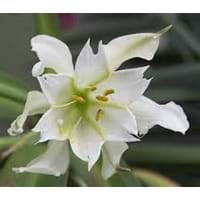Life Span
Perennial
Perennial
Type
Bulb or Corm or Tuber
Sedge or Rush
Origin
South America
Africa
Types
Pamianthe cardenasii , Pamianthe parviflora , Pamianthe peruviana
C. papyrus, C. papyrus 'Nanus
Habitat
All sorts of environments
Lakes, Shores of rivers or lakes, sluggish streams and rivers, Swamps
USDA Hardiness Zone
8-10
7-11
Sunset Zone
21,22
H1, H2, 16, 17, 23, 24
Habit
Clump-Forming
Clump-Forming
Flower Color Modifier
Bicolor
Bicolor
Leaf Color in Spring
Dark Green
Green, Light Green
Leaf Color in Summer
Light Green
Green, Light Green
Leaf Color in Fall
Several shades of Green
Green, Light Green
Leaf Color in Winter
Light Green
Green, Light Green
Leaf Shape
Strap shaped
Grass like
Plant Season
Spring, Summer, Fall
Spring, Summer, Fall, Winter
Sunlight
Partial Sun, Partial shade
Full Sun, Partial Sun
Type of Soil
Loam, Sand
Clay, Loam, Sand
The pH of Soil
Acidic, Neutral, Alkaline
Neutral
Soil Drainage
Average
Poorly Drained
Bloom Time
Spring, Late Spring, Early Summer, Summer, Late Summer
Indeterminate
Tolerances
Drought
Drought
Where to Plant?
Ground, Pot
Container, Ground, Pot
How to Plant?
Offsets
Stem Planting
Plant Maintenance
Medium
Medium
Watering Requirements
Keep the ground moist but not water-logged
Average Water Needs, Keep ground moist, Requires a lot of watering
In Summer
Lots of watering
Lots of watering
In Spring
Moderate
Moderate
In Winter
Average Water
Average Water
Soil pH
Acidic, Neutral, Alkaline
Neutral
Soil Type
Loam, Sand
Clay, Loam, Sand
Soil Drainage Capacity
Average
Poorly Drained
Sun Exposure
Partial Sun, Partial shade
Full Sun, Partial Sun
Pruning
Pinch or prune as they grow to promote branching and bushiness, Remove damaged leaves, Remove dead branches, Remove dead leaves, Requires little pruning
Remove damaged leaves, Remove dead branches, Remove dead leaves
Fertilizers
All-Purpose Liquid Fertilizer, High phosphorus
All-Purpose Liquid Fertilizer
Pests and Diseases
Leaf spot, Mosaic viruses
fungus
Plant Tolerance
Drought
Drought
Flower Petal Number
Single
Single
Foliage Texture
Coarse
Not Available
Foliage Sheen
Glossy
Glossy
Attracts
Bees, Birds, Bumblebees, Butterflies, Hummingbirds, pollinators
Flying insects, Hummingbirds
Allergy
Unknown
Not Available
Aesthetic Uses
Beautification, Bouquets, Ornamental use, Showy Purposes
Showy Purposes
Beauty Benefits
No Beauty Benefits
Not Available
Edible Uses
No
Insignificant
Environmental Uses
Air purification
Air purification
Medicinal Uses
No Medicinal Use
Cancer, Heals minor burns, Wounds
Part of Plant Used
Not Available
Stem
Other Uses
Beneficial species for attracting pollinators, Decoration Purposes
Constructing Boats, Used as fuel, Used in paper industry
Used As Indoor Plant
No
Yes
Used As Outdoor Plant
Yes
Yes
Garden Design
Bog Garden, Container, Feature Plant, Foundation, Mixed Border, Water Gardens
Bog Garden, Container, Feature Plant, Houseplant, Mixed Border, Water Gardens
Botanical Name
HYMENOCALLIS longipetala
CYPERUS 'Wild Spike'
Common Name
Peruvian Daffodil, Spiderlily
Papyrus, Wild Spike Cyperus
In Hindi
peruvian daffodil
पेपिरस संयंत्र
In German
peruvian daffodil
ägyptischen Papyrus-Pflanze
In French
peruvian daffodil
Papyrus égyptien
In Spanish
Pamianthe
Papiro egipcio
In Greek
peruvian daffodil
αιγυπτιακό πάπυρο
In Portuguese
peruvian daffodil
Papiro egípcio
In Polish
peruvian daffodil
Papiro egipcio
In Latin
peruvian daffodil
CHARTA
Phylum
Magnoliophyta
Magnoliophyta
Class
Liliopsida
Agaricomycetes
Family
Amaryllidaceae
Cyperaceae
Clade
Angiosperms, Monocots
Angiosperms, Commelinids, Monocots
Tribe
Clinantheae
Cariceae
Subfamily
Amaryllidoideae
Cyperoideae
Number of Species
Not Available
Not Available
Season and Care of Peruvian Daffodil and Egyptian Papyrus
Season and care of Peruvian Daffodil and Egyptian Papyrus is important to know. While considering everything about Peruvian Daffodil and Egyptian Papyrus Care, growing season is an essential factor. Peruvian Daffodil season is Spring, Summer and Fall and Egyptian Papyrus season is Spring, Summer and Fall. The type of soil for Peruvian Daffodil is Loam, Sand and for Egyptian Papyrus is Clay, Loam, Sand while the PH of soil for Peruvian Daffodil is Acidic, Neutral, Alkaline and for Egyptian Papyrus is Neutral.
Peruvian Daffodil and Egyptian Papyrus Physical Information
Peruvian Daffodil and Egyptian Papyrus physical information is very important for comparison. Peruvian Daffodil height is 61.00 cm and width 61.00 cm whereas Egyptian Papyrus height is 60.00 cm and width 60.00 cm. The color specification of Peruvian Daffodil and Egyptian Papyrus are as follows:
Peruvian Daffodil flower color: White
Peruvian Daffodil leaf color: Dark Green
Egyptian Papyrus flower color: Tan
- Egyptian Papyrus leaf color: Green and Light Green
Care of Peruvian Daffodil and Egyptian Papyrus
Care of Peruvian Daffodil and Egyptian Papyrus include pruning, fertilizers, watering etc. Peruvian Daffodil pruning is done Pinch or prune as they grow to promote branching and bushiness, Remove damaged leaves, Remove dead branches, Remove dead leaves and Requires little pruning and Egyptian Papyrus pruning is done Remove damaged leaves, Remove dead branches and Remove dead leaves. In summer Peruvian Daffodil needs Lots of watering and in winter, it needs Average Water. Whereas, in summer Egyptian Papyrus needs Lots of watering and in winter, it needs Average Water.





